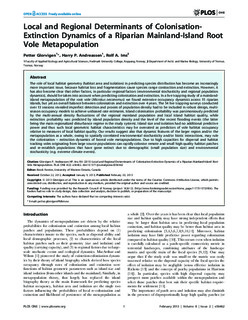Local and Regional Determinants of Colonisation- Extinction Dynamics of a Riparian Mainland-Island Root Vole Metapopulation
Journal article, Peer reviewed
Permanent lenke
http://hdl.handle.net/11250/134512Utgivelsesdato
2013Metadata
Vis full innførselSamlinger
Originalversjon
Glorvigen P, Andreassen HP, Ims RA (2013) Local and Regional Determinants of Colonisation-Extinction Dynamics of a Riparian Mainland-Island Root Vole Metapopulation. PLoS ONE 8(2): e56462. doi:10.1371/journal.pone.0056462 10.1371/journal.pone.0056462Sammendrag
The role of local habitat geometry (habitat area and isolation) in predicting species distribution has become an increasingly
more important issue, because habitat loss and fragmentation cause species range contraction and extinction. However, it
has also become clear that other factors, in particular regional factors (environmental stochasticity and regional population
dynamics), should be taken into account when predicting colonisation and extinction. In a live trapping study of a mainlandisland
metapopulation of the root vole (Microtus oeconomus) we found extensive occupancy dynamics across 15 riparian
islands, but yet an overall balance between colonisation and extinction over 4 years. The 54 live trapping surveys conducted
over 13 seasons revealed imperfect detection and proxies of population density had to be included in robust design, multiseason
occupancy models to achieve unbiased rate estimates. Island colonisation probability was parsimoniously predicted
by the multi-annual density fluctuations of the regional mainland population and local island habitat quality, while
extinction probability was predicted by island population density and the level of the recent flooding events (the latter
being the main regionalized disturbance regime in the study system). Island size and isolation had no additional predictive
power and thus such local geometric habitat characteristics may be overrated as predictors of vole habitat occupancy
relative to measures of local habitat quality. Our results suggest also that dynamic features of the larger region and/or the
metapopulation as a whole, owing to spatially correlated environmental stochasticity and/or biotic interactions, may rule
the colonisation – extinction dynamics of boreal vole metapopulations. Due to high capacities for dispersal and habitat
tracking voles originating from large source populations can rapidly colonise remote and small high quality habitat patches
and re-establish populations that have gone extinct due to demographic (small population size) and environmental
stochasticity (e.g. extreme climate events).
